One of the most interesting categories of amplifiers is the battery-powered amp. Not too long ago, they were largely seen as toys and novelties, but thanks to modern advances in battery technology, manufacturers have squeezed out more power, making amps louder and allowing them to offer a full feature set.
If, like many, your previous experience with battery amps was just mini versions of famous amps on a belt clip, you might find yourself lost when looking through today’s options. This is why we’ve prepared this KillerGuitarRigs Review. In it, we’ve covered the best battery-powered amps on the market, reviewing their features, build quality, and, of course, their tones.
If you’re looking for a battery-powered amp, you won’t want to miss this!
Read more about our review process.
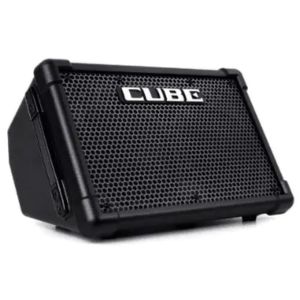
Roland CUBE Street EX
Features: 50 Watts of power, 2 Mic/Inst inputs, COSM amplifier modeling
Benefits: PA Functionality, Tons of tone options, Gig ready power
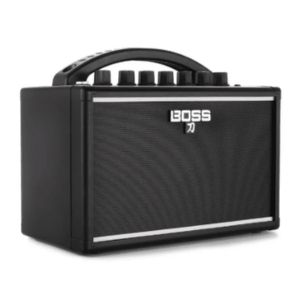
Boss Katana Mini
Features: Clean/Crunch/Brown voicings, Aux input, Built in delay effect
Benefits: Up to 7 hours of battery life, Fantastic sound through headphones, Enough power for any campfire singalong
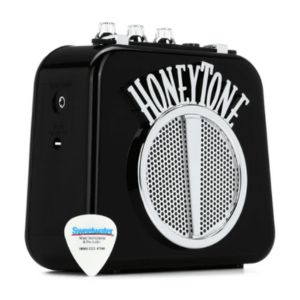
Danelectro Honeytone N-10
Features: 9V battery power, Integrated belt clip, Leather handle
Benefits: Great tone, Highly portable, Good volume for practice
Contents
Our Top 3
The Boss Katana Mini was our Top Pick. It delivers the same extraordinary modeling technologies as its big brothers, and the sound quality is simply phenomenal, given the price and size.
We found the Danelectro Honeytone N-10 to be a great choice for value-conscious shoppers, which is why we named it our Best Budget option. It comes in fun colors, with retro designs, and offers awesome sound quality considering its tiny price.
If you’re looking for the very best battery amp on the market, you can’t beat our Editor’s Choice, the Roland Cube Street EX. It has power and tone in abundance, it’s highly portable and genuinely built to last, making it the ultimate amp for those on the go.
Individual Reviews
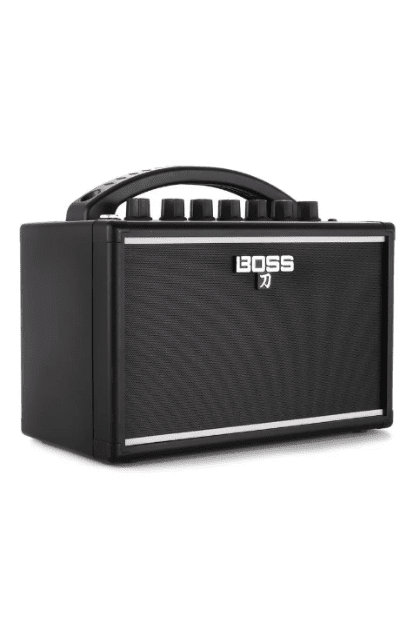
Boss Katana Mini
An absolute powerhouse in the small battery powered amp category.
It’s not often that a mini version of an amp actually lives up to the standards set by the full size models, but this is no ordinary battery powered amp. It uses modeling technology to provide a range of quality tones, and offers great volume with excellent battery life, making it ideal for everything from bedroom practice to subway station busking.
The Boss Katana Mini is driven by the same technology behind its big brothers in the Katana range (such as the incredibly popular 50w model), so as expected, it turned out to be one of the most versatile amps in this roundup.
With 7 watts of power driving the 4″ speaker, it was loud, punchy, and remarkably clear from minimum to maximum volume. Considering its tiny size, this is no mean feat.
Using the 3-band EQ, we were able to dial in a wide range of tones and really shape our sound. Additionally, it had 3 amp voicings. If you’re familiar with the larger Katana models, you’ll likely recognize them. It had a clean mode, which delivered bell-like clarity, a crunch setting for a mid-gain overdriven rhythm sound, and finally, “Brown” mode served up some frankly awesome distorted yet articulate lead tones.
The impressive features didn’t end there, either. To add some texture to the tones, it also came with a delay function, which sounded like a quality tape-delay emulator.
We found the aux input to be very useful for practicing with a backing track, and the headphone-out was great for practicing in silence, too.
As for power, it took 6 AA batteries and had a runtime of just under 7 hours. It can run from mains power as well, using the available AC adapter – making it one of the most versatile mini-amps that doesn’t sound like a mini amp.
Verdict: The Boss Katana Mini is an absolutely fantastic battery-powered amp that perfectly blends price and performance. The tones are superb, and the selectable voicings really give it big-amp character. The sound quality is so good that you could even mic it up and record with it in a pinch.
- Built in FX
- Modeling capabilities
- Great battery life
- Fewer amp voices than other modelers in the category
- Bulky carry handle
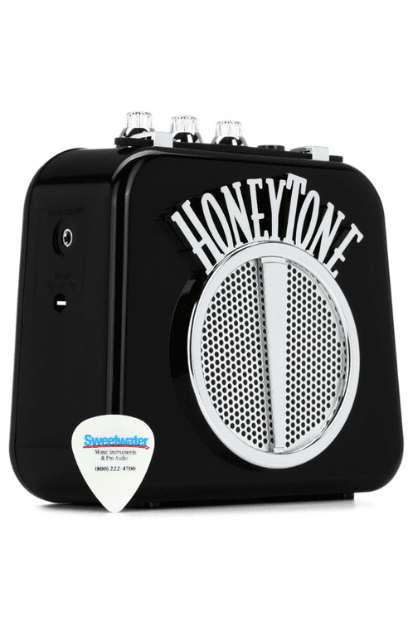
Danelectro Honeytone N-10
Great tones and cool styling in a tiny package.
This tiny battery powered amp comes in a range of cool retro colors and really nails the vintage styling. Despite its size, it still offers a good array of features, including a useable overdrive knob, an AC power option, and a headphone output.
The Danelectro Honeytone N-10 is the type of amp people assume you’re talking about when you mention battery-powered. It really was tiny and due to the small size and light weight, we even found that the belt clip was useful.
Even though it had an all-plastic construction, it still felt sturdy and would definitely stand up to some knocks, bumps, and maybe some drops. So you can feel confident taking it out and about.
It had just 1.5w of power, but this was more than enough to push its 2.5″ speaker. Operation of the amp was incredibly simple. The power on/off switch was paired with the volume knob, and the control panel had just two other dials – tone and overdrive.
We played it clean to start, with the tone at noon and the overdrive off, and it delivered a really sweet and clear tone. With the tone knob dialed back, it took on a warm, bluesy sound. With the tone cranked, it was sharp but not brittle. Considering the low price and small size, the clean performance of this amp was a huge and extremely pleasant surprise.
The overdrive function was another great touch. It gave us some fantastic crunchy rock tones, and even when pushed hard, we didn’t find that it became muddy or unclear in any way.
Having a headphone-out is pretty much standard for amplifiers these days, but especially because of the tiny dimensions of this Danelectro Honeytone, it almost feels like a headphone amp, particularly when worn on a belt.
It was powered by a single 9V battery, which we got a good six hours of use out of. As with most battery-powered amps, an AC adapter is available for a separate purchase. So, if you are looking to use it at home, you can always invest in the adapter to save money on batteries.
Verdict: The Danelectro Honeytone N–10 is an absolute riot to play. It’s extremely inexpensive and delivers some great tones, which seem even better when you consider the price. We found it to be well-made and well-appointed, given the confines of the unit’s small size. It would make a great first practice amp for somebody just getting into electric guitar or a fantastic travel amplifier if you plan on taking your practice out on the road.
- Only needs 1 x 9v battery
- Belt clip
- Great clean performance
- Limited control options
- Comparatively quiet
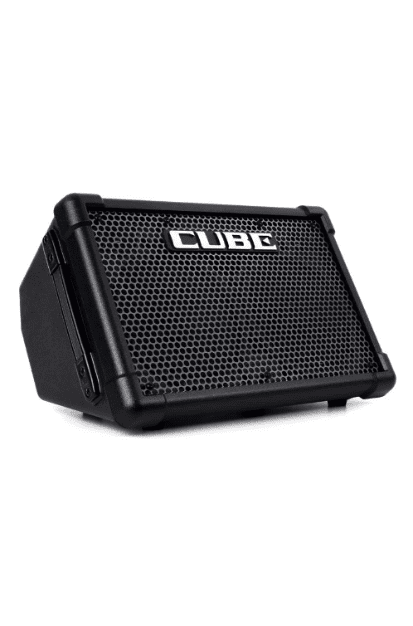
Roland Cube Street EX
Dynamic performance and unmatched tones.
If you need a Powerful amp/PA for jamming, street performances, or just practice at home, this is the ultimate choice. It offers the controls of a full featured amplifier and Will run for several hours on AA batteries alone.
The Roland Cube Street EX is the travel amp that thinks it belongs in a studio. It’s heavier than the others in this roundup, but at just 16.4 pounds, it was still extremely portable and easy to carry.
It was absolutely rock solid and was clearly built to withstand the rigors of street performing, as well as life on the road.
With a whopping 50W of power, we found it to be incredibly loud, certainly enough for any situation in which a battery-powered amp could be useful. All of this power was delivered by way of 2×8″ speakers, resulting in well-defined, crisp tones.
When we say it was full-featured, we weren’t exaggerating. It had multiple inputs for both microphones and guitars, with three-band EQ for each channel. In addition to the EQ, it had reverb and chorus/delay effects.
On top of all this, it also featured Roland’s COSM modeling technology. It had voicings for an acoustic simulator, which allowed us to get a relatively authentic-sounding acoustic tone from an electric guitar, plus a clean voice, which was incredibly crisp and articulate. There was a crunch setting that gave us some nice mild-to-moderate overdrive for a great rhythm tone and a lead setting, which delivered high gain/borderline-distorted tones.
We were amazed at the fact that such an amplifier could be powered by just eight AA batteries! We got about five hours of battery life at full power, but it also featured a power-saving mode in which we could Attenuate down to 25 or just 10W, allowing us to squeeze even more time out of the batteries. If you’d prefer to play from Mains power, it did accept a DC adapter.
The list of features didn’t end there, either. As expected, it had a headphone-out jack, but it also had a stereo link, which allows you to connect a second Roland cube for true stereo. Finally, it even has a foot-switch input, making it truly gig-ready.
Verdict: The amount of features that have been squeezed into the Roland Cube Street EX is absolutely astounding. Whether you want to gig with it, practice with it or even just use it as a PA or loudspeaker, it offers all of those features and more. It’s a rock-solid amplifier and offers some of the best tones you’ll hear from any battery-powered amp on the market.
- Requires just 8 AA batteries
- High end modeling capabilities
- Built in attenuator
- Heavy
- Shorter battery life

Pignose 7-100 Legendary
A unique design & fantastic overdriven tones.
This amp is a great choice for anybody looking for a battery powered amp with distinctive looks and high end overdriven tones. It offers a compact design, quality construction and its an absolute blast to play.
The Pignose 7-100 Legendary has been a dressing-room favorite of some of the biggest names in rock & roll since the 1970s. Its simplicity is a big draw for many, although a little bit of knowledge is required to get the best out of it.
It had a punchy 5-inch speaker pushed by a 5-watt amplifier stage. It had the simplest controls of any amp we have ever reviewed at KGR, with a solitary pignose-shaped volume knob on the front.
We did find that having such basic controls made us focus more on playing technique than fiddling with settings, but this does make it a difficult amp for novices to enjoy. In fact, to modify the tone, we had to open the amp casing by varying amounts and blend those adjustments with subtle changes in the volume.
As we mentioned, experienced players will likely love the challenge of dialing in tones on an amp that acts like an old-school tube model. With the volume low, it gave us some quality cleans. And just like a tube amp, as the volume went up, so did the breakup. Around noon, it served up some nice rhythm crunch, and when cranked, it absolutely screamed.
It was a highly portable option, weighing in at under 5 pounds even with the six AA batteries required to power it on board. It had a convenient carry handle, making it easy to transport, and each of the unit’s corners had metal protectors to assist in preventing damage when you take it out and about.
On battery power, we got around 5 hours of use, which was quite impressive. If you find that you want to use a Pignose regularly, you’ll probably find it beneficial to use the AC adapter (sold separately).
Verdict: The Pignose 7-100 Legendary might be the simplest battery-powered amp in this roundup, but it still packs a huge punch and delivers some surprisingly versatile performance. New players might struggle to get the best out of this amp, but persistence will be rewarded with some extremely memorable tones.
- Cool looks
- Large speaker
- Excellent tones
- Difficult to adjust sound
- Bulky design
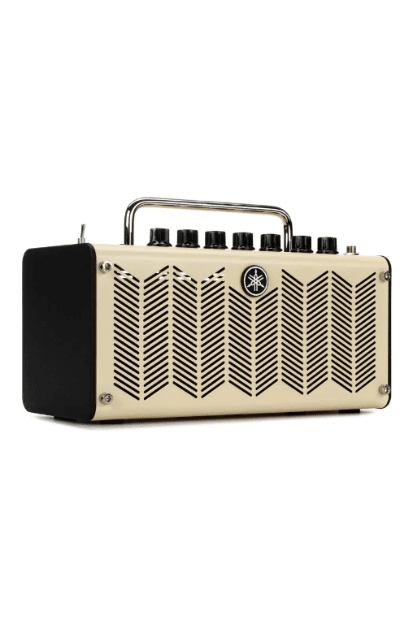
Yamaha THR 5
A battery powered desktop amp to rival any wired combo.
This amp has been critically acclaimed for both its performance and its looks ever since its initial release. It’s built to the usual high Yamaha standards, and it delivers premium performance in terms of its tones and feature set, which includes a suite of editable amp models.
We loved the responsive nature of the Yamaha THR5’s two 3″ stereo speakers. They reacted well to changes in playing dynamics, although they did sound a little thin compared to other models in the roundup. The 10 watts of available power provided plenty of volume for everything from solo practice to low-key jam sessions (full review here).
Considering the feature set, it had a fairly simple control layout. We would have liked to have seen a 3-band EQ rather than the single tone knob, but this was a fairly minor complaint. We were able to easily access the five preset amp voicings (clean, crunch, lead, Brit hi, and modern) directly through a simple knob.
Not only did it have five frankly excellent amp models, but using the Yamaha companion app, we were able to modify the amp parameters and even download new models from the community of THR users.
For even more sound and tone customization, it had a selection of effects, including chorus, flanger, phaser, and tremolo, as well as a range of delay and reverb FX, including delay, delay/reverb, spring reverb, and hall reverb. We were able to get some fantastic tones from these built-in effects. For the casual user, there would be genuinely no need for external pedals.
One of the great things about the THR5 is that it also doubles up as a USB interface, allowing for easy recording without the need to buy additional hardware.
Unlike most of the amps in this review, the THR5 actually came with an AC adapter, which was a big plus. On six standard alkaline AA batteries, we got around 6 hours of battery life, which was around average.
Verdict: The Yamaha THR5 was very well-made, looked excellent and was fantastically portable. It had the feature set of a standard wired amp yet worked flawlessly using regular AA batteries. The modeling features were fantastic, and having a full suite of FX built in makes it a truly attractive option.
- Comes with AC adapter
- Built in FX
- Operates as USB interface
- No 3 band EQ
- Many settings had to be controlled via the app
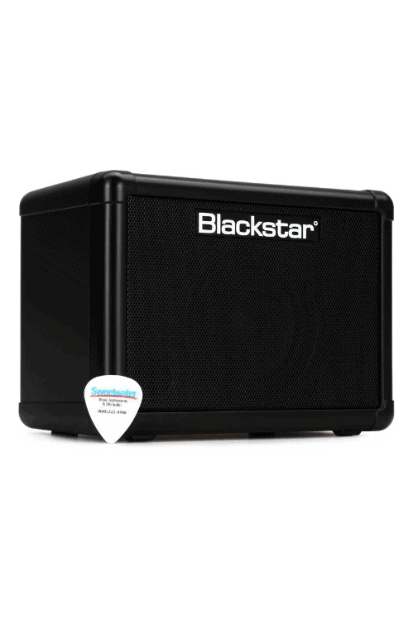
Blackstar Fly 3
Unbelievable tones from one of the most compact amps on the market.
This model is a favorite amongst new players looking for an affordable small amp, and pros looking for a quality travel unit alike. Despite its tiny size, it boasts 2 channels, a fantastic tape delay effect, and even Blackstar’s famous ISF tone shaping feature.
For only having 3 watts of power, we found that the Blackstar Fly 3 was really loud when pushed hard, but the coolest thing about it was its ability to perform with great tone at low volume. This is why it’s become a favorite practice amp for many. It makes use of a single 3″ speaker, and if you’re looking for stereo tones, Blackstar does sell an extension cabinet for this model.
The control layout was extremely simple, with knobs for volume, gain, EQ, delay time, and delay level. The EQ control was actually responsible for the ISF, or infinite shape feature. The intent is that rather than being a simple tone control, it shifts the sound from a bright, crisp American amp to a dark, gritty British tone. Think Fender to Marshall. While we loved the concept, the nuances were difficult to pick up on, and it did end up behaving more like a standard tone control than anything else.
Even so, we found that it was clear and well-articulated at high volumes, and we’d go so far as to say rich and warm at low levels. This is rare at amps of this size. The clean channel was bright with a lot of shimmer, and the overdrive channel actually got pretty gnarly with the gain up.
The tape delay was quite authentic-sounding and really easy to control with the two separate knobs. It did have the tendency to get a little messy when maxed, but if we avoided max time and max level together, it was quite useful.
Build quality was a little disappointing. The whole thing was made with hard plastic, which, while sturdy, scratched very easily. On top of that, the rubber feet were just glued on and would likely come off with ease.
Power came from 6 AA batteries, which gave us around 4.5 hours of use. An AC adapter is available separately should you want to play without relying on batteries.
Verdict: The Blackstar Fly 3 is a cool little amp that delivers some quality tones in a user-friendly format. It may not have the premium build quality of some of the other models we tested, but as one of the most affordable models in the roundup, this is understandable.
- Great volume
- Useful overdrive chanel
- Excellent built in delay
- Build quality issues
- ISF feature felt gimmicky
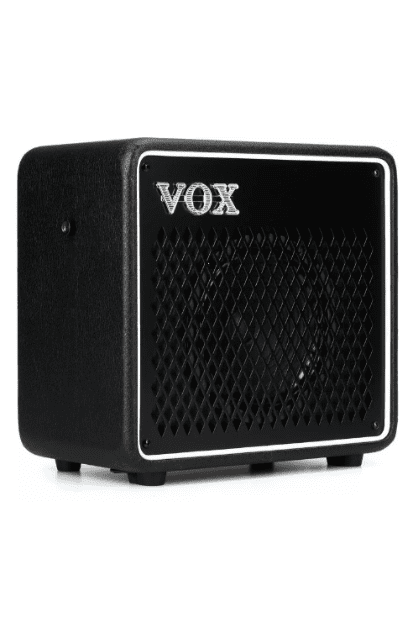
Vox Mini Go 50
Huge power and excellent modeling capabilities.
For players who insist on power and portability, there aren’t many better options than this Vox. It boasts a huge 50 watts of power through an 8” speaker, plus an insane array of features including a looper, a mic input, and swing out raisers to allow players to angle their amplifier up.
The Vox Mini Go 50 is a behemoth in the world of battery-powered amps. It has tons of features and comes from a brand that have made amps for some of the biggest acts in history.
It made good use of the 50 watts of power, delivering huge volume through the 8” speaker. The speaker itself was one of the weaker areas for this amp, especially at high volume. It got just a touch muddier than expected, but fortunately, this amp does accept aftermarket speakers if you choose to upgrade.
It had something of a complicated control layout, too. We obviously understand that by packing this many features into an amp, a range of controls are necessary. But there was a huge amount of real estate on the top of this amp, and the controls were crammed into a small section, making the markings hard to read.
We did like the range of preset Vox amp models built right into the controls. There were ten models to choose from, and they were all surprisingly effective. We also liked the range of built-in FX and the 3-band EQ.
The build quality was very good with the Mini Go 50. It was sturdy and clearly capable of taking a knock or two. On the front feet, there were extenders, allowing us to tilt the amp, which is a really nice touch and something we wish more amp-makers would do.
There were no built-in batteries with this model, nor was there space for disposable cells. It actually drew power from an external USB battery bank. This was quite a cool concept, but it’s worth noting that it did not come with a power pack, and that would need to be purchased separately. Battery life will, of course, depend on the mWh of the battery pack you use.
Verdict: The Vox Mini Go 50 is a great choice for everyone, from street performers to garage-band jammers. It offers the power needed to keep up with a band and also a flexible battery arrangement. The fact that it came with a looper built in was a real bonus.
- 10 Amp models built in
- External USB power
- Looper functionality
- Control layout is complicated
- Muddy at high volume
How to Choose the Right Amp For You
To find the best battery-powered amp, there are a few areas that you should pay particular attention to while shopping around. Keep on reading to learn more about them.
Battery Type
There are three main types of battery power for amplifiers.
First, there is the built-in rechargeable battery. These are typically the most convenient. Simply plug in the amp, let it get a full charge, and take it anywhere without any additional accessories. The downside to these amps is that if they die when you’re out and about without access to mains power, there’s no possibility to keep going. Additionally, the battery’s max charging capacity will naturally diminish over time, and it may not be replaceable.
Some amps take disposable batteries, which offers the flexibility of being able to carry spares or purchase additional batteries as necessary. They can be expensive to run in the long term, however, as it’s not uncommon for amps to use as many as eight batteries at a time.
It’s now also possible to buy amps that run from USB battery banks. Typically, they are purchased separately from the amp, and lifespan will vary depending on the size you choose. Like disposable battery-powered amps, it’s easy to carry spares, but as with the fixed-battery amps, if you run out of juice and don’t have access to a charger, there’s no way to power the amp.
Speaker Size
Battery-powered amps come with some of the smallest speakers of any amplifier, with some being as tiny as 2.5”. As with any amp, the larger the speaker, the better the frequency response. However, larger speakers can add significant weight, making the amp heavier and less portable.
Portability
On the topic of portability, the overwhelming majority of players looking for battery-powered amps are hoping to be able to take them out and about, either for busking or just hanging out with friends. Consider the physical size and weight of the amp you need before deciding. If you’re looking at a high-powered amp, be sure it has comfortable carry handles or straps to make taking it out with you easier. If you want to be completely mobile, consider one of the smaller amps with a built-in belt loop.
Final Thoughts
We had a ton of fun testing each of these battery-powered amps. We found ourselves amazed at the capability of today’s models, with features we never thought we’d see on such compact units.
To recap our favorites from this roundup…
Our Top Pick was the Boss Katana Mini. We love the Katana family of amps at KGR, and this battery-powered marvel definitely lived up to the reputation with its stellar sound and build quality. Our Best Budget option, the Danelectro Honeytone N-10 gave us some awesome tones and offered incredible fit and finish, considering how cheap it was. Our Editor’s Choice winner was the Roland Cube Street EX. This is a performance-ready mini PA that runs on batteries, it’s loud, it sounds amazing, and it offers a ton of awesome modeling features.


